Overcoming Objections in Sales: Examples, Templates, Proven Tactics
Jenny Keohane
Contents
One of the best skills to have in B2B sales is the ability to turn sales objections into opportunities.
Nobody likes rejection, but sales objections allow you to narrow your focus on your buyer’s fears and then tailor your message accordingly.
Objections essentially give you further insight into your prospect’s view. However, knowing how to respond to rejection can be challenging.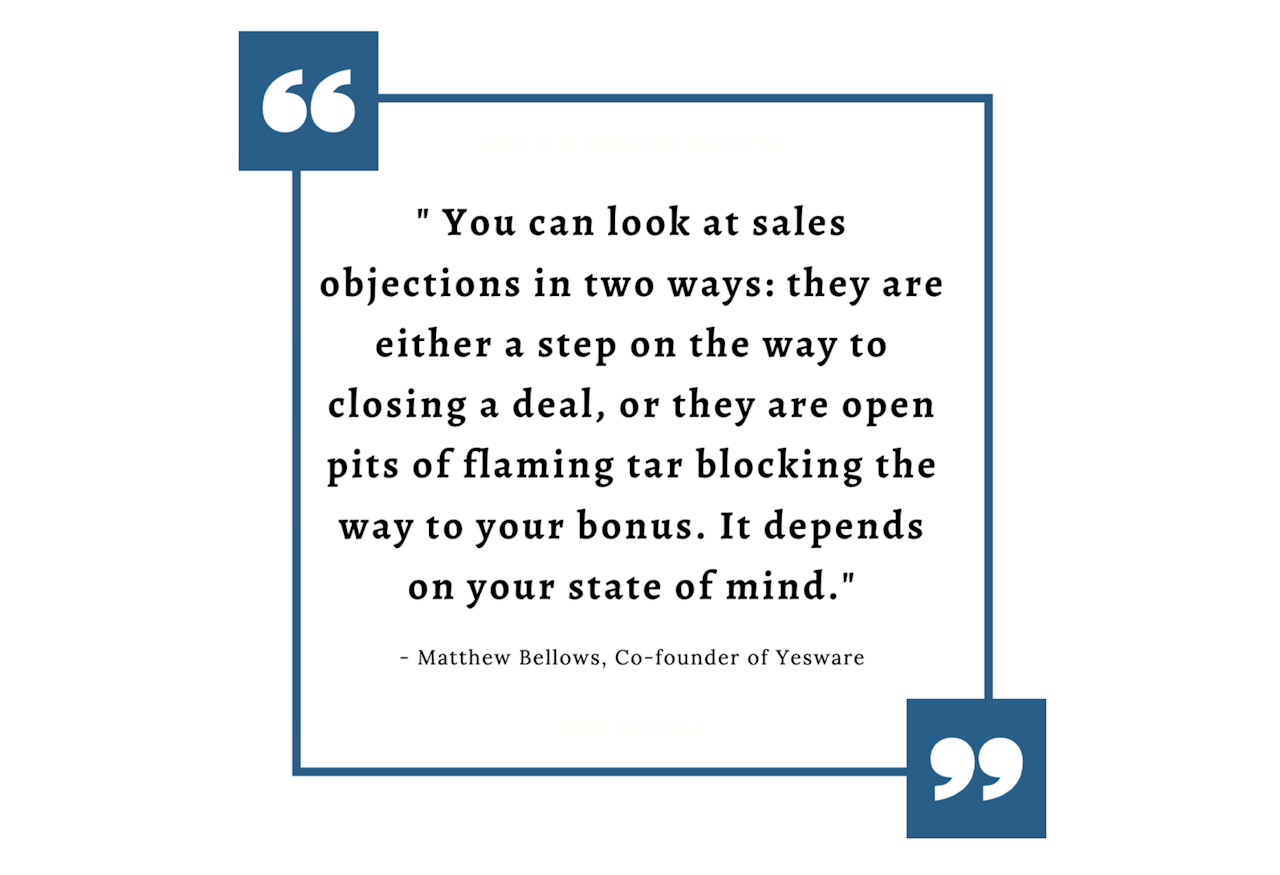 Below, we discuss four research-backed principles for overcoming objections with real-world cold email and cold call examples. We also tackle the best ways to answer the most common sales objections with proven strategies and processes.
Below, we discuss four research-backed principles for overcoming objections with real-world cold email and cold call examples. We also tackle the best ways to answer the most common sales objections with proven strategies and processes.
Here’s what we’ll cover:
- What Is a Sales Objection?
- Why Overcoming Objections Is Important in Sales
- Types of Sales Objections
- How to Overcome an Objection
- How to Train Sales Reps to Overcome Objections
- Proven Tactics for Overcoming Objections
- Common Sales Objections & How to Overcome Them
What Is a Sales Objection?
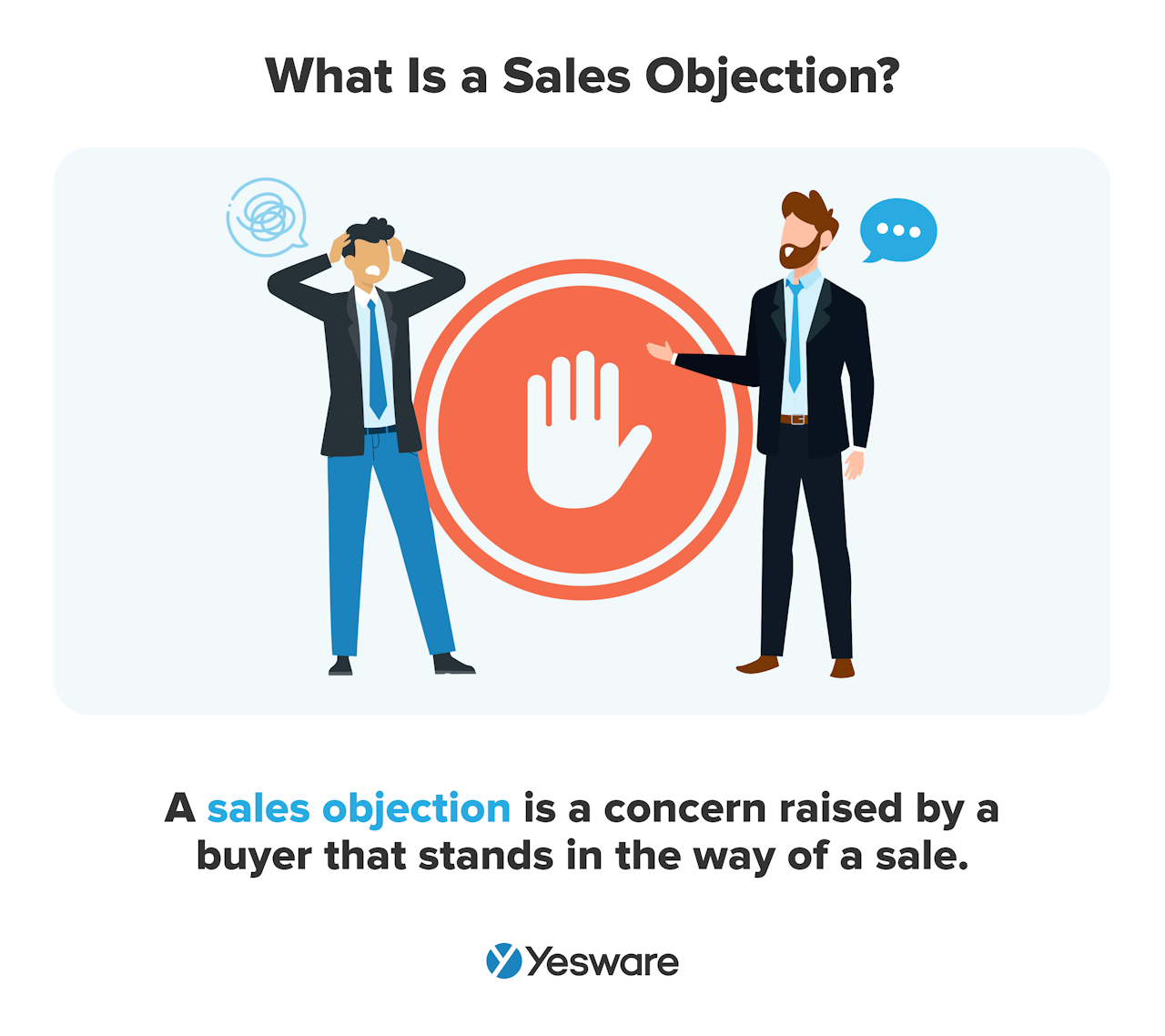
A sales objection is a concern raised by a buyer in a sales conversation. This concern typically stands in the way of the prospect buying your product/service.
Sales objections act as barriers in the sales process and need to be addressed as soon as they arise to continue moving the deal forward.
The most common sales objections have to do with price, competitors, and product uncertainty.
Why Overcoming Objections Is Important in Sales
Overcoming objections in sales is crucial. Why? Because objections stand in the way of the purchase. Buyers won’t feel comfortable moving forward if their concerns aren’t alleviated.
Salespeople can’t do their jobs without facing objections, but the fate of the deal depends on how well the salesperson responds to the objection.
Your response can either make or break the deal. So it’s safe to say this is a significantly important step in the sales process.
Types of Sales Objections
There are five common categories that the majority of sales objections fall under: 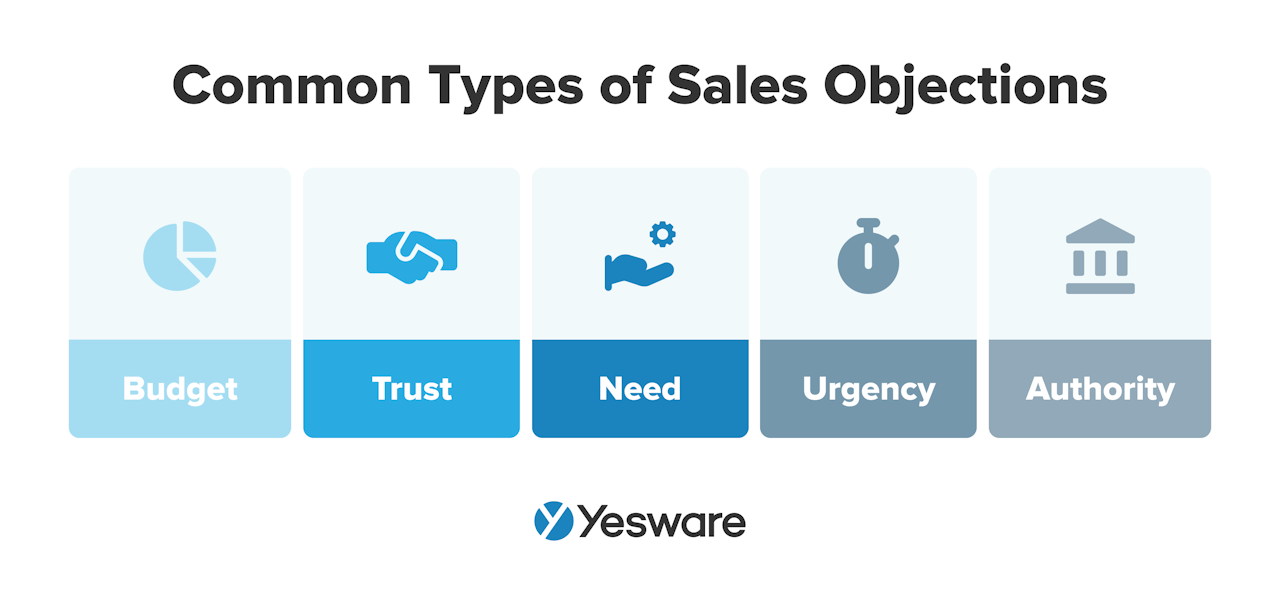 All five of these represent a form of “lack” that the prospect is experiencing.
All five of these represent a form of “lack” that the prospect is experiencing.
- Lack of Budget: Objections that focus on the price of the product/service.
- Lack of Trust: Objections that demonstrate a lack of trust in your company.
- Lack of Need: Objections that question whether your product/service is right for the prospect.
- Lack of Urgency: Objections that demonstrate timing is an issue.
- Lack of Authority: Objections that state the prospect doesn’t have the authority to make the decision.
How to Overcome an Objection
The four-step process outlined below is the most common and successful way to overcome an objection. 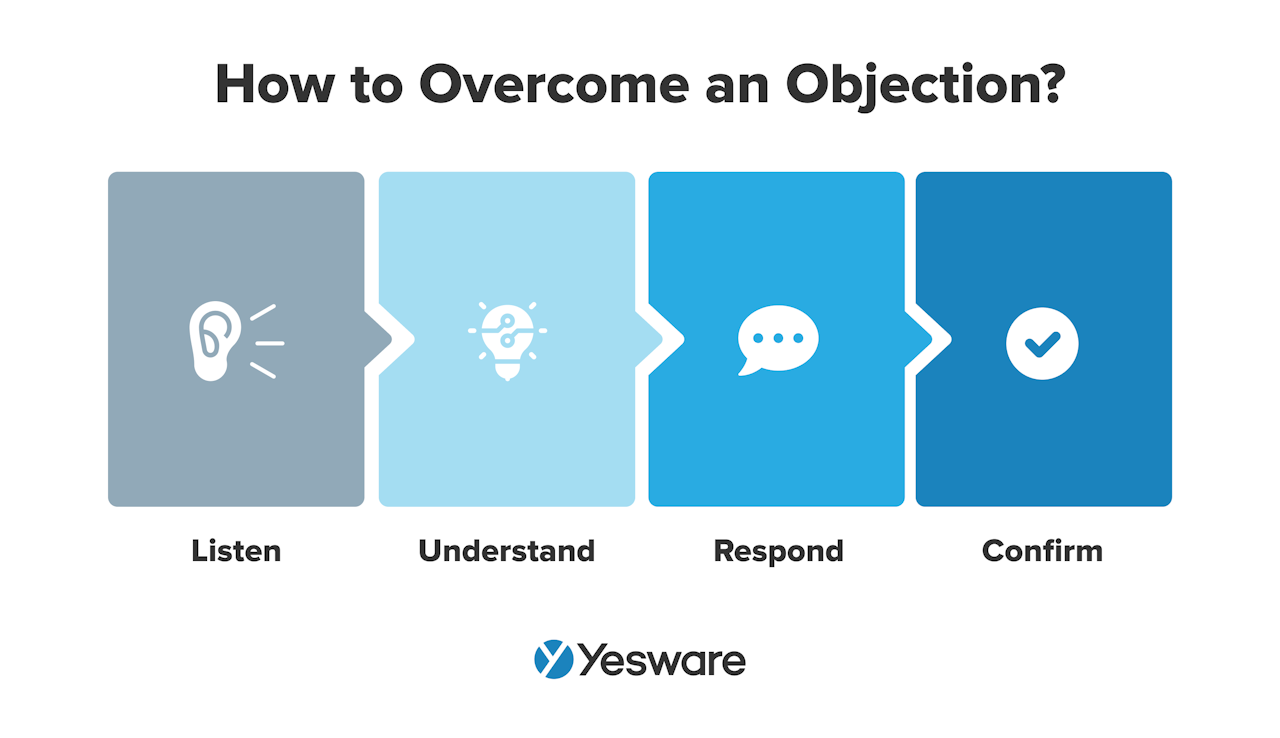
1. Listen
First and foremost, listen thoroughly to your prospect’s objection. Don’t jump in, get defensive, or react before they’re done expressing themselves. Fully listen and comprehend what they’re saying.
Listening will not only help show the prospect you genuinely care about what they have to say (which will help build rapport between the two of you), but it will also help you form a more strategic, well-thought-out response that addresses their concern head-on.
Here are some active listening skills you can try on for size: 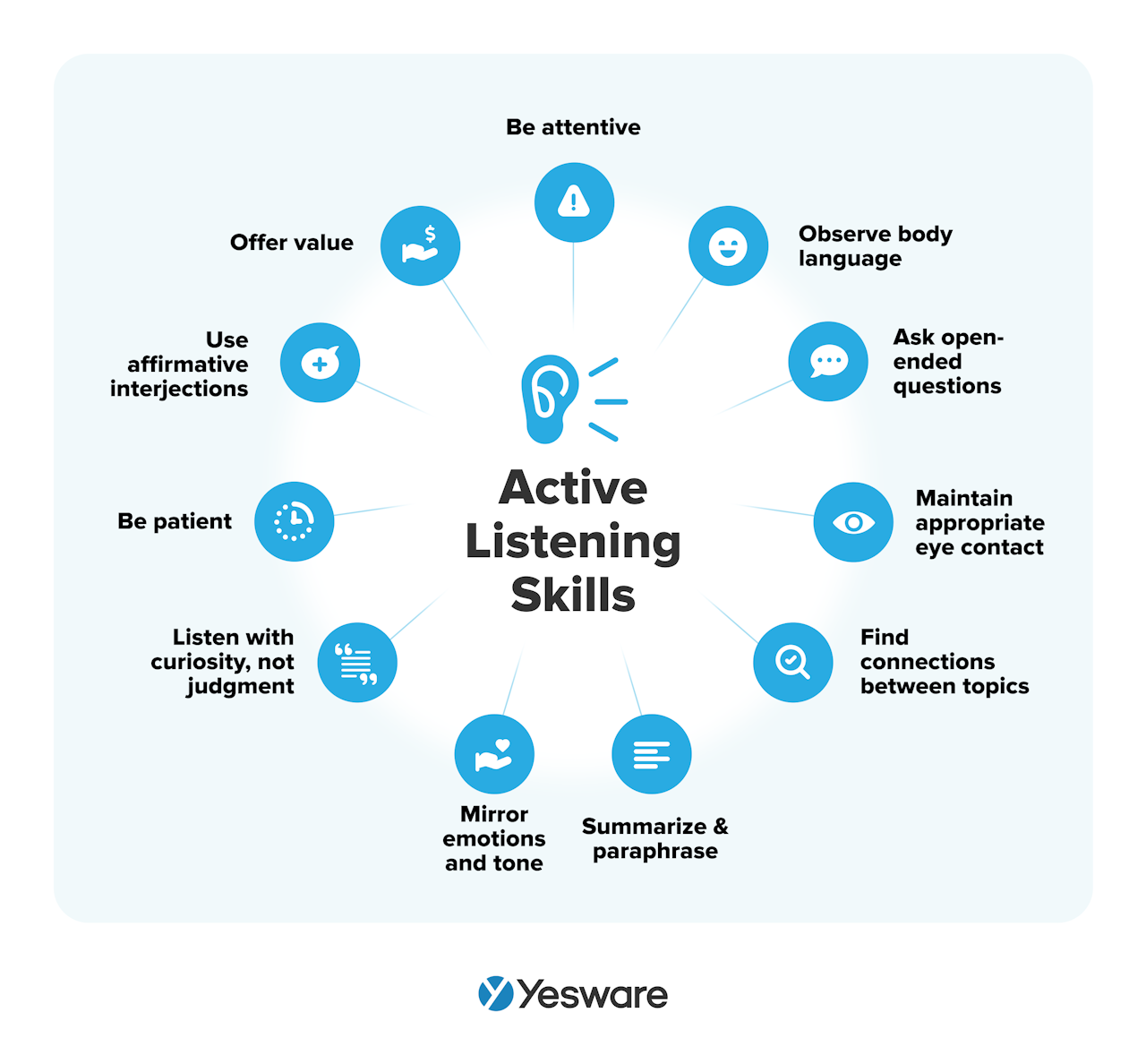
2. Understand
Oftentimes, sales objections hide underlying issues. Your job as the sales professional is to dissect this underlying issue to fully understand the objection at hand.
One of the best ways to ensure you fully understand the problem is to ask the prospect open-ended sales questions. The more you get your prospect talking, the better you’ll respond to their objection in a way that’s catered to their specific needs.
Remember, ensure your questions are open-ended, not closed-ended. Here’s the difference: 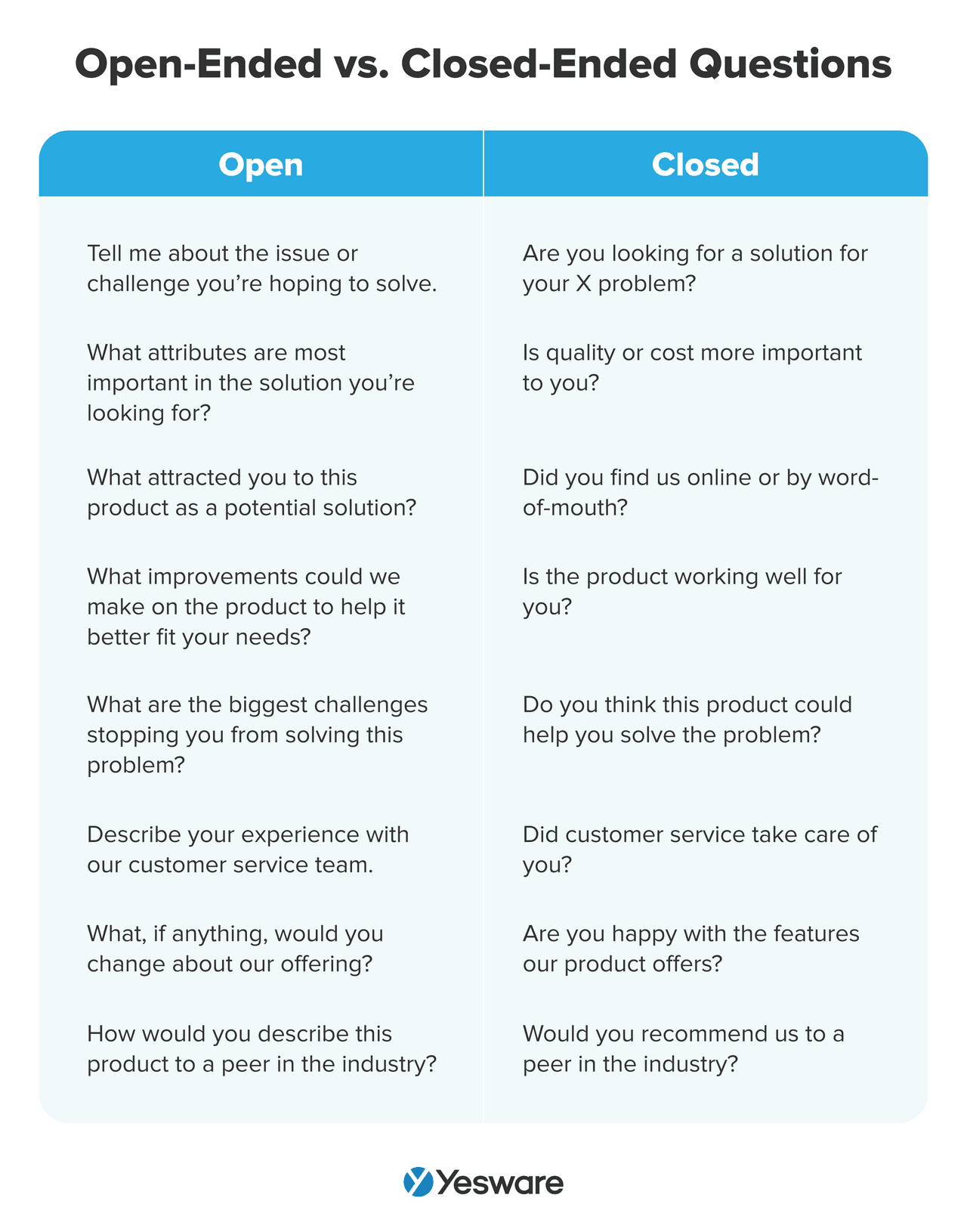
3. Respond
Now, respond to the objection. We’ll get into various examples and tactics below on how to do this. But one of the most important factors to keep in mind is with your response, make sure you acknowledge that their objection is valid.
Then, address the objection head-on. Don’t beat around the bush. Let them know you understand their concern, but you have a solution and present it in a way that’s personalized to their specific situation.
4. Confirm
Now that you’ve responded to the objection ask whether your response solves their problem/ eases their concerns. If it did, then you know you can move forward with the deal. If it didn’t, then you open up the conversation to further discussion.
It’s worth noting that if your response doesn’t resonate and you don’t see a clear solution, the prospect might not be the right fit, which is okay. If they’re not ready, don’t force it.
How to Train Sales Reps to Overcome Objections
When managing a sales team, from the get-go, it’s essential to instill a mindset that objections are opportunities, not blockers.
Objections can identify solvable pain points and allow salespeople to understand the prospect and their current situation further.
You can do this by creating a culture of continuous learning — embrace challenges, talk about them, learn from them, and better yourselves because of them.
Once this culture is established, sales reps won’t be as afraid of sales objections. Because at the end of the day, it’s all about mindset.
Proven Tactics for Overcoming Objections
1. Reframe – Turn Sales Objections Into Opportunities
One way to change someone’s mind is to show them a perspective they may not have previously considered.
The key is to build your response around information your prospect has already acknowledged is true. This makes it harder to argue with you without being contradictory.
It’s kind of like scrolling through Instagram filters. The underlying content of the photo stays the same, but changing the filter alters the feeling you get from the image.
Real-world use case: “We already work with a competitor.” Reframe their response to position your offering as either 1.) complementary to the existing solution or 2.) uniquely different.
Check out this email exchange example. In less than 40 words, the rep acknowledges the incumbent competitor and then reframes the conversation (earning major sales objection kudos in the process).
In the following examples – names, private information, and company names are changed.
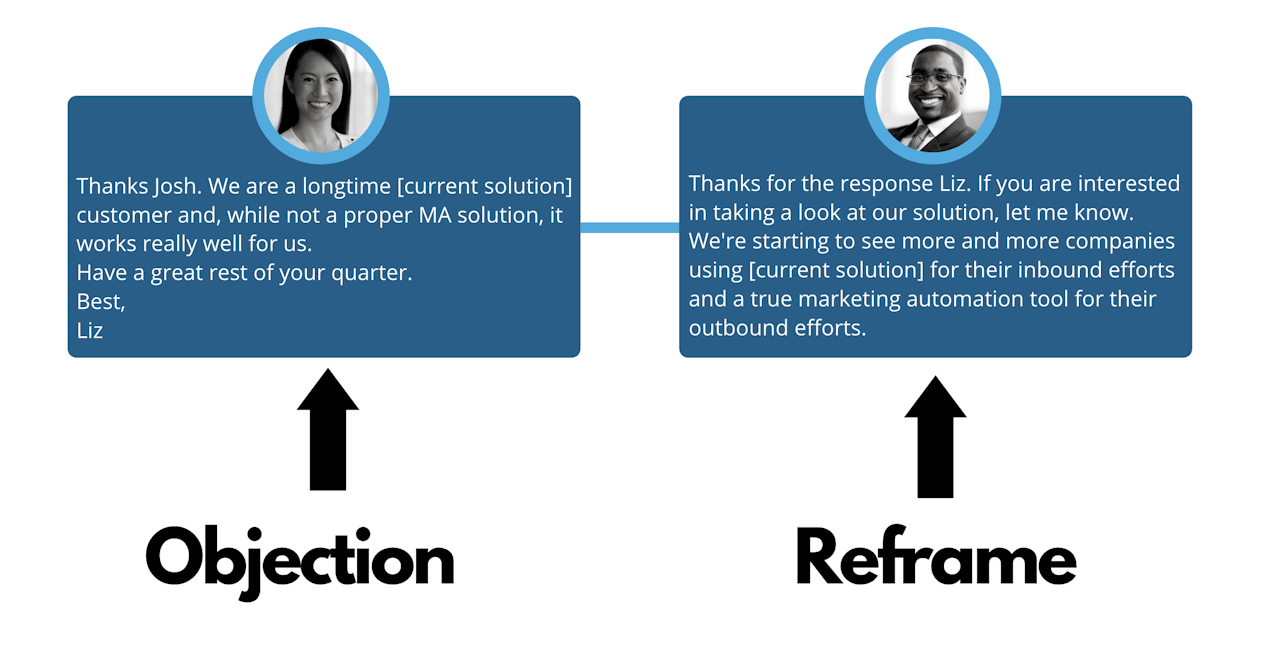
2. The Best Friend Formula
One of the best ways to bury an objection is to use the Best Friend Formula, coined by our very own Head of Sales, Ian Adams.
This three-part formula helps overcome sales objections by establishing harmony — it reassures people that you’re on their side, like a best friend. And it works on any of these sales objections:
And it works on any of these sales objections:
- “We already work with a competitor”
- “This isn’t a priority right now”
- “Email me your information”
- “Not interested”
Real-world use case: “Email me your information” (when you’re on a cold call). Don’t fall for the brush-off. Instead, treat the person on the other end of the line like they’re your friend you can relate to and that you genuinely want to help.
Here’s how Ian Adams perfected this technique with the “just email me” objection. Ian used the Best Friend Formula to successfully turn a cold shoulder into a booked meeting:
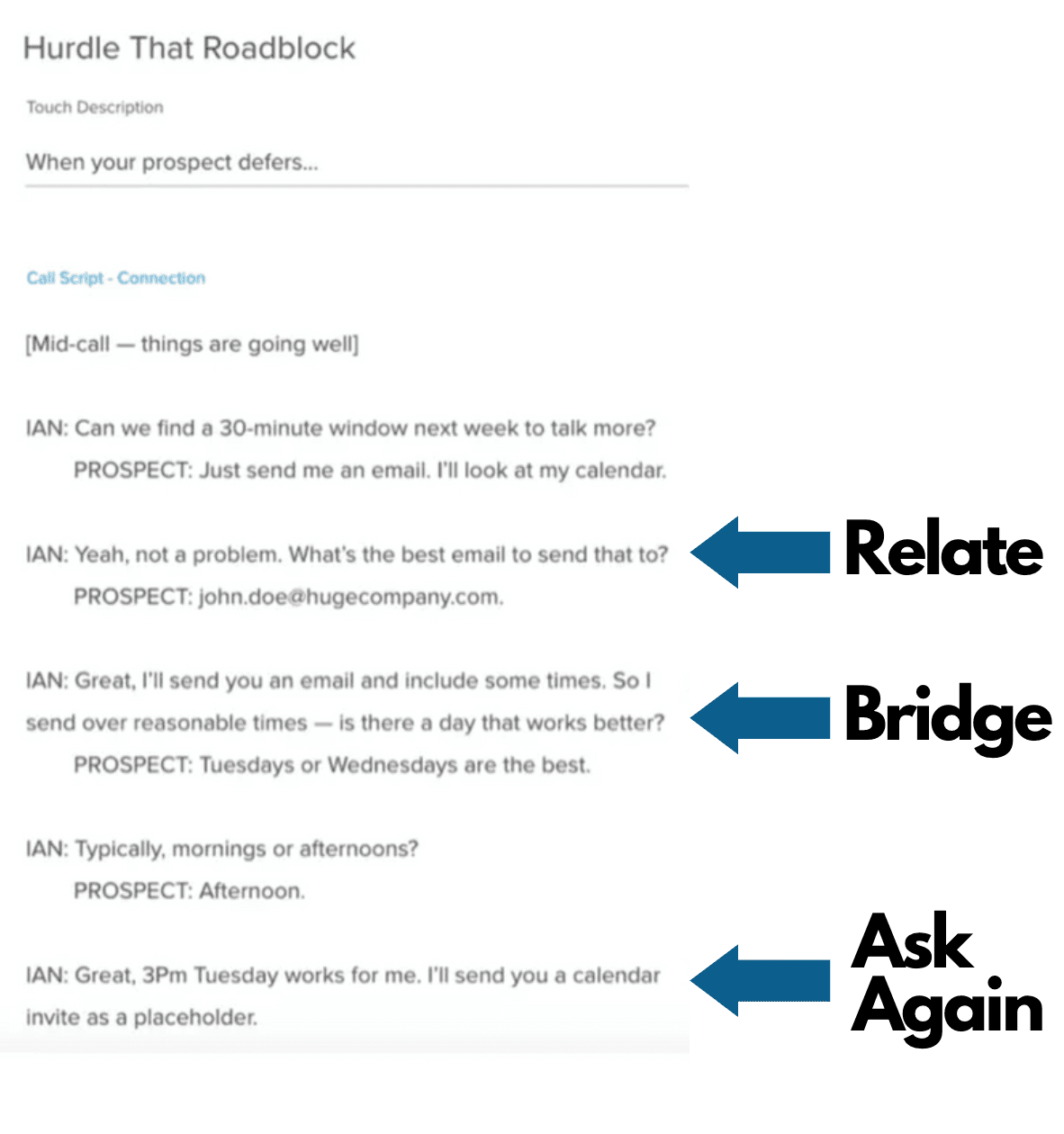
Notice how he didn’t fight the objection head-on? Ian worked with his prospect to get to the end goal together — well done.
3. Objection Chunking – Take a Step Back and Look at the Big Picture
Another fantastic way of overcoming objections is using the objection chunking tactic.
Asking someone to take a wider perspective has a twofold effect:
- It reframes the situation to create a new understanding.
- It distracts from what might be a difficult issue to resolve.
Real-world use case: “This isn’t a priority right now.” Keep the door open for further conversation and deflect attention away from the present issue by taking a higher, more general viewpoint.
Here’s how one sales rep employed this technique to land a meeting with a Yesware team member. Notice how he calls out the small-time commitment at the end? Hard to argue with that.
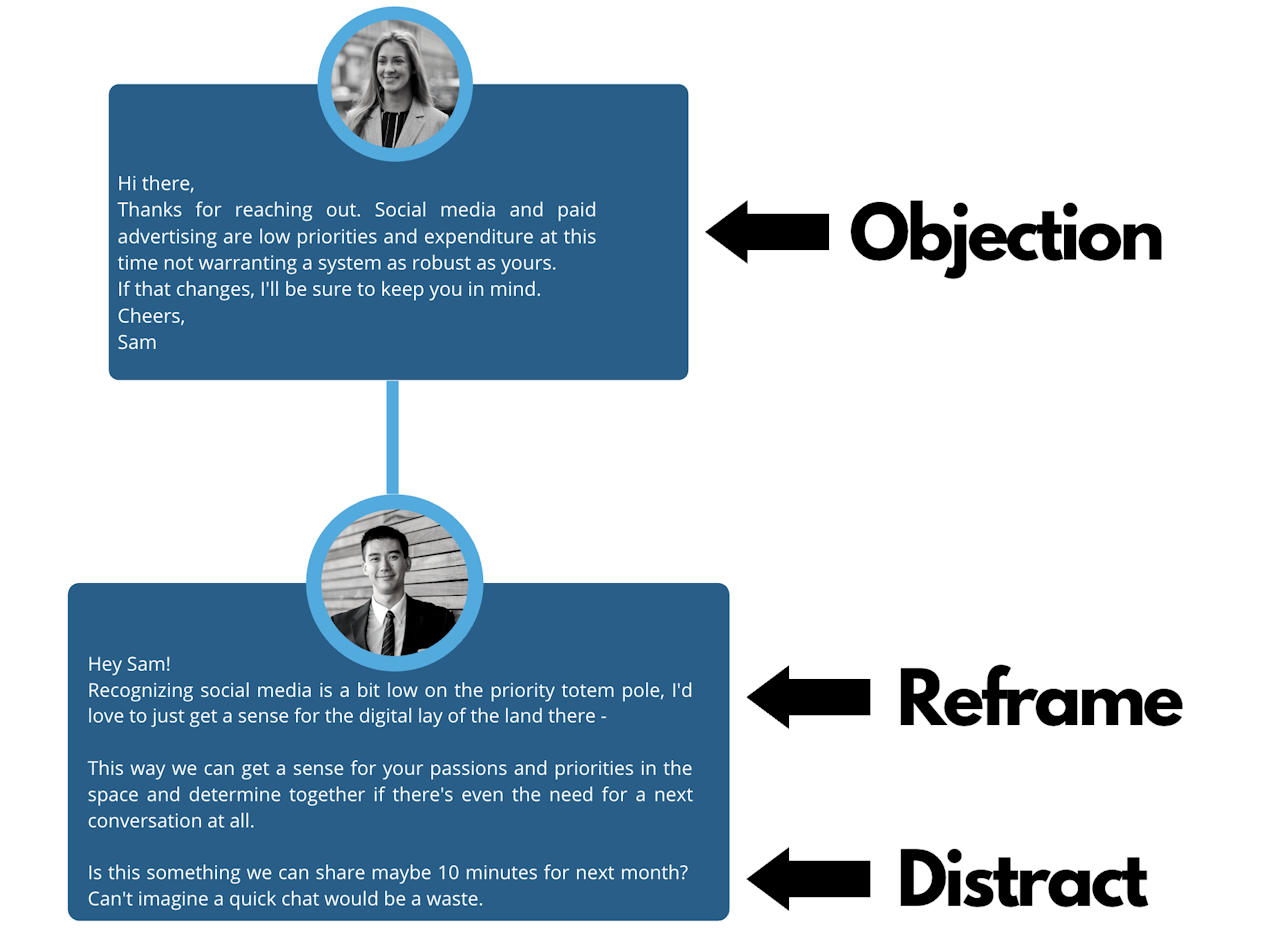
4. Curiosity – Gain Their Interest By Asking Open-Ended Questions
About 40% of everyday conversation is devoted to telling others what we think. In fact, a study by Harvard University neuroscientists found that when people talk about themselves, it gives their brains as much pleasure as money or food.
That’s why questions can be so powerful. When you ask someone a question about themselves, there is a strong neurological incentive for them to answer.
Real-world use case: “Not interested.” The more you understand why they’re shutting you down, the better equipped you are to disarm their objection. Keep the conversation going by expressing genuine curiosity about their situation and where their interests lie.
The key here is to ask open-ended questions. Get your prospects talking by asking questions that involve a thorough response.
Make your prospect feel understood and validated. Recognize and address their concerns before asking questions. By ensuring their concerns are valid, they will feel more comfortable and willing to discuss their feelings.
Tip: Grab some more tactics for overcoming objections and closing deals with our data-backed guide below.
 Sales Engagement Data Trends from 3+ Million Sales ActivitiesLooking at millions of tracked email activity over the past few years, this ebook is filled with our top studies and findings to help sales teams accelerate results.
Sales Engagement Data Trends from 3+ Million Sales ActivitiesLooking at millions of tracked email activity over the past few years, this ebook is filled with our top studies and findings to help sales teams accelerate results.
Common Sales Objections & How to Overcome Them
These 12 sales objections are some of the most common objections brought up in 2023.
We look at how to respond to each of these below with various templates for you to use in your own sales conversations. 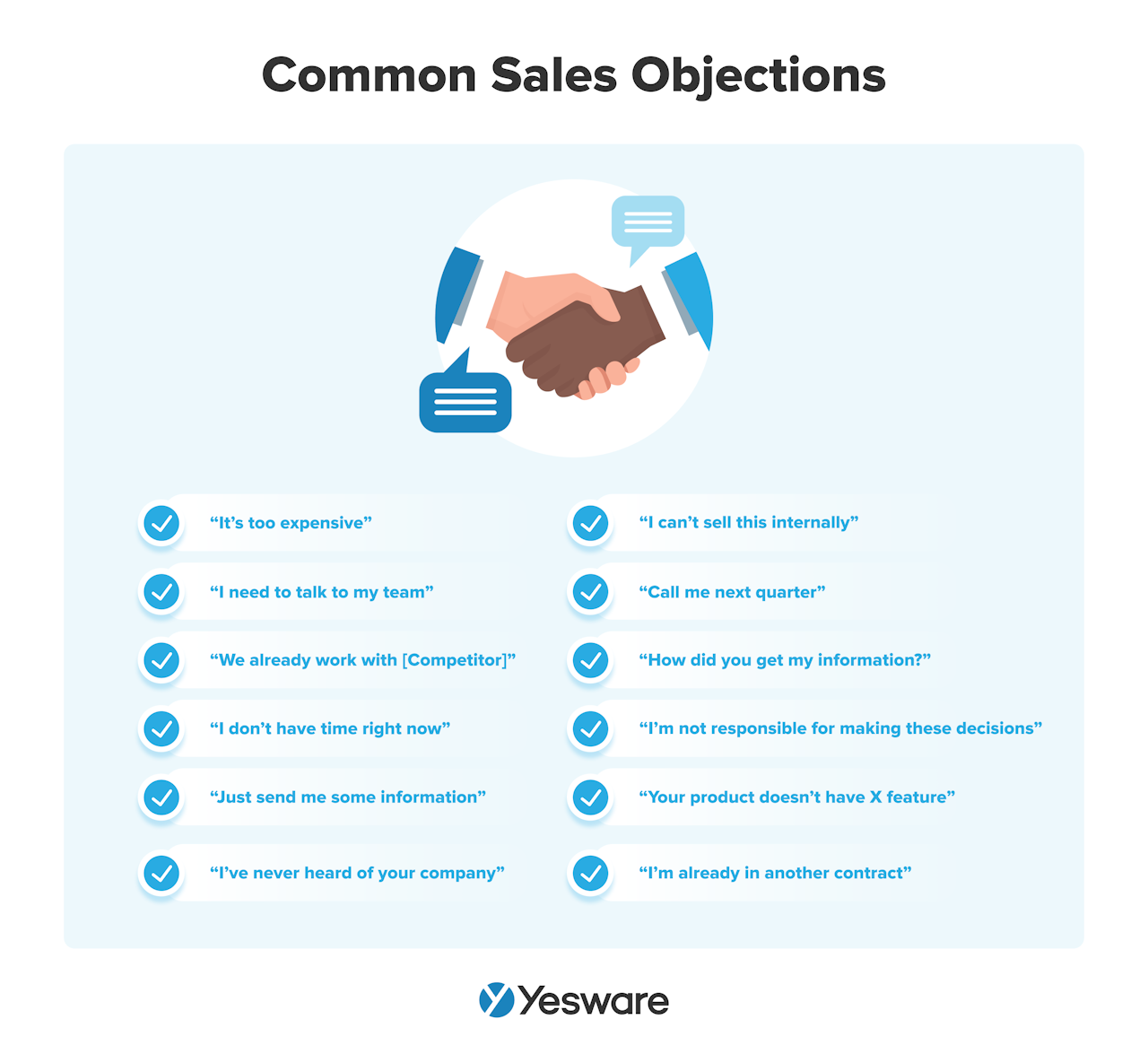
1. “It’s too expensive”
Price objections are the most common sales objection there is. Why? Because money is at the top of every buyer’s mind. But the price is all about perceived value.
If you make the value of your product/service known first, you will significantly minimize the likelihood of this objection arising.
But sometimes it’s inevitable. When presented with this objection – emphasize any free trials your business offers and state that they don’t need to make any decision off price just yet, bringing the conversation back to your product/service. The more you can talk about your solution and its benefits, the more they will instinctively justify the price without even realizing it.
You can also ask the prospect why they think your product is too expensive. The prospect then has to break down their reasoning, which gives you further insight into their perspective.
How to respond to this sales objection:
“We don’t expect you to buy anything from us right now. We are just looking to show you [Product/Service] and see if it is of value to you and your business [Lead this into a further question about their needs].”
“Can you tell me a little more about why you think [Product/Service] is too expensive?”
2. “I need to talk to my team”
Sometimes, this is the case. Most of the time, they’re procrastinating in making a decision.
If you have correctly qualified your prospect in your discovery call, then you will be fully aware of whether you are speaking to the decision-maker or not.
The best thing you can do is keep the process moving by offering to talk to all parties. Getting all decision-makers in one room will give you more control over the sale and help you facilitate the decision – you can present as much insight as possible.
Depending on your situation, if you already have the prospect on board and they just need their team’s agreement, use this to your advantage. Ask them what specific elements are most important to the parties you’re speaking to next. This will give you the leg up you need to take a highly personalized approach.
How to overcome this objection:
“I understand. If it makes it easier for you, I can hop on a call or come in for a meeting to explain [Product/Service] to your team. When would be the best time to do this?”
3. “We already work with [Competitor]”
The competitor objection is actually a best-case scenario objection. Why? Because the business has already recognized a need, and the solution they’ve acquired must be similar to yours. Your job is much easier when the person you’re talking to has already identified a pain point.
The best way to overcoming objections like this one is to ask questions about how their experience has been so far with the competitor. Pay attention to any complaints they may have and use these to your advantage. You then have the leverage you need to emphasize why your solution is better by understanding more of what’s important to them.
You can also reference a customer who used the same product or service and transitioned to yours, emphasize what they’ve seen as advantages since adopting your solution, and any pain points that have been solved. Provide social proof to back up your claim.
How to respond to this sales objection:
“We’d love the opportunity to show you how we are different and how customers have found additional value with our solution in regards to using [Competitor].”
“Can I share a case study with you that shows how a company similar to yours was able to reduce/increase [outcome] by switching from [Competitor] to our solution?”
“I understand. May I ask you how your experience has been so far with [Competitor]?”
4. “I don’t have time right now”
This sales objection is tough. It’s basically another way of saying, “This isn’t important to me right now,” or it’s just a cop-out.
The best way to overcome this sales objection is to politely ask the prospect if you are calling at a bad time or if there is a current business problem they’re dealing with. If the problem has to do with their business, use this as leverage. Take the factors mentioned and zero in on how your solution can help ease their pain.
For example, if your product/service helps with productivity and makes their lives easier – this is a great time to emphasize that.
How to overcome this objection:
“Totally understand. If you don’t mind me asking, what are your company’s other priorities right now?”
“I hear you, it’s a crazy time of year. What other time would work best for you? Just looking for 5 minutes to show you how we can help reduce your stress and give you more time in the day.”
5. “Just send me some information”
This sales objection is an easy way out. But if you respond right, this objection can give you clear insight into what the prospect is looking for, and essentially how you can sell to them.
A sales tactic for handling this objection is to ask the prospect what they’re looking for in this information – which gets them talking about their needs. Listen attentively here and identify pain points. Then you can fine-tune your proposal so it’s personable and catered to the prospect and their business.
Another way of handling this objection is to offer a demo so they can see your solution hands-on. Emphasize that customers have found this to be an easier method for understanding your product.
How to handle this objection:
“I’d be happy to send you some information, but may I ask you a few questions to make sure I send you the most relevant information for you and your business?”
“People tend to find it more valuable seeing [Product/Service] hands-on, would you be interested in a quick demo?”
6. “I’ve never heard of your company”
When cold calling, this is a common sales objection that represents a lack of trust.
This objection is actually a great opportunity to highlight your value proposition. Who are you? And what makes you unique? This objection provides you with another chance to win them over. So make sure you have a great value prop up your sleeve.
How to respond to this objection:
“We’re a company that provides [ideal customer] with [solution.] I’d love to show you exactly how we can do that for your business.”
“We help companies struggling with [pain point] by providing them with [solution]. Is your business currently dealing with this as well?”
7. “I can’t sell this internally”
Not everyone is a sales professional like you. This sales objection has a very easy fix – they don’t have to sell your product internally; you’ll do it (or at least help them). You’re the pro, after all.
Ask the prospect what kind of objections they foresee arising when presented internally so you can prepare the right material.
Ask the prospect why they think so. That way, you gain first-hand information about how the internal business operates, what they prioritize, and who you might address.
Here are some ways to overcome this objection with ease:
“Totally understandable. Can you share with me why you think so? What objections do you see arising? I can prepare the right material and ensure all these issues are addressed and resolved.”
“I would love the chance to speak with your team directly and show them exactly why I think [Product/Service] will help your business achieve [outcome].”
8. “Call me next quarter”
This sales objection represents a lack of urgency. If this objection is true and not just a brush-off, then they’ll be able to provide you with an explanation of why.
This sales objection gives you the opportunity to prove to the prospect why the issue they’re facing is more urgent than they think. This is where social proof can really come into play.
Has a customer of yours faced a similar issue, saw the first-hand consequences of the issue, and then solved it by using your product/service? If so, this is the perfect time to bring up this proof.
Here’s how you can do it:
“I can definitely call you next quarter. But before you hang up, I wanted to share that our customer [Customer Name] was struggling with the same issue for over a year before buying [Product/Service], and they saw [social proof – decrease in traffic, sales, productivity, etc.]. I would hate for that to happen to you. Can I send you the case study that shows how they went from [numbers before] to [numbers after]?”
9. “How did you get my information?”
This is another common sales objection you’ll face if you’re a cold caller or emailer. That’s okay; there are a lot of workarounds to this objection.
As long as you’re doing sales right (have a valid reason for reaching out and have conducted thorough research), you’ll be able to back up your reasoning pretty easily.
Tell them where you got their information, but first explain to them why you sought their information to begin with. This explanation gives you an opportunity to reiterate why they’re a good fit for your offering.
Here are some ideas for overcoming this objection:
“I was researching [types of businesses] and came across your website. I saw you were hiring for [position] and thought if you were looking for help in this realm, that [Product/Service] could solve those missing pieces for you without needing a new hire.”
“I found your company on LinkedIn and saw that you recently announced [announcement]. I thought that [Product/Service] would be a great help with this new transformation.”
“I read your blog post about [topic], and it really resonated with me. I did some more research into your company and saw an opportunity for [Product/Service] to help your team achieve [results].”
10. “I’m not responsible for making these decisions”
Ah, the classic lack of authority objection. This is one of the easiest sales objections in the book to get sales reps off the phone. But don’t let it be.
Okay, so who is responsible? Work for that well-deserved introduction to the correct decision-maker. Or better yet, leverage this objection to learn more about the decision-making process so you can reach the right decision-maker the next time around.
Here are some responses to this sales objection:
“Thanks for letting me know, and sorry for bothering you. May I ask who on your team handles this type of decision? Can you point me in the right direction?”
“Apologies for getting it wrong. Who does make these decisions on your team? I’d love a chance to speak with them and help them solve [pain point]. Could you introduce me?”
11. “Your product doesn’t have X feature”
Ah, product-related objections are some of the most difficult to combat because, well, you can’t change your product; you’re no engineer.
But if you truly believe there is a good fit here, you’ll be able to explain to your prospect why this one blocker doesn’t affect your product’s overall value.
There are a few different ways you can do this — do you have a feature that makes up for this missing feature? Is there a workaround? Is this specific feature on your team’s product roadmap? Is there another product that pairs with your product to solve this missing feature?
Your response to this objection entirely depends on your specific product. But here are some common ways companies overcome objections around missing features:
How to respond:
“Ah, yes, that is true. That’s why our [another feature] functionality makes up for this missing piece. Here’s why: [value proposition].”
“That’s a valid concern. But I have some good news. Our customers who feel this is a missing element have paired [different product/service] with ours and found it’s a great workaround that easily solved their problems.”
“You are not the first person to tell us that. Our team is actually working on building that feature into our product as we speak. We expect it to be live on [predicted date].”
12. “I’m already in another contract”
This sales objection is hopeful because it demonstrates interest. Another pro of this objection is it gives you leverage to ask whether the prospect is happy/fulfilled with their current contract. And if they’re not, you have an even better chance to take that spot.
But what if there’s a price associated with breaking the contract?
This is where you can offer any discounts that will help compensate for the cost. Or, re-demonstrate the ROI of your product that justifies any additional charges.
How to overcome this objection:
“Are you happy with your current contract? If not, I’m more than happy to offer you a discount to compensate for the cost of switching.”
“Based on our conversation, it seems that [Product/Service] will solve [pain points] more than [Current Product/Service]. Because I’m so confident this will be a beneficial switch, I’m happy to provide you with a discount to compensate for any additional costs.”
Turn Sales Objections Into Opportunities
In B2B sales, changing your mindset to view sales objections as opportunities will undoubtedly improve outcomes.
Always follow objections with questions. This will only give you further opportunities to learn more about your prospects.
The common sales objections above are, in many cases, an instinctive response. Always work on uncovering the truth or getting down to the root cause of the hesitation.
Overcoming objections in sales isn’t easy – but if you listen to their objection, acknowledge that you hear them, and ask questions to better understand their underlying issues – you will find objections don’t always end in a cold shoulder.
This guide was updated on November 22, 2023.
Get sales tips and strategies delivered straight to your inbox.
Yesware will help you generate more sales right from your inbox. Try our Outlook add-on or Gmail Chrome extension for free, forever!
Related Articles
Casey O'Connor
Casey O'Connor
Jenny Keohane
Sales, deal management, and communication tips for your inbox

